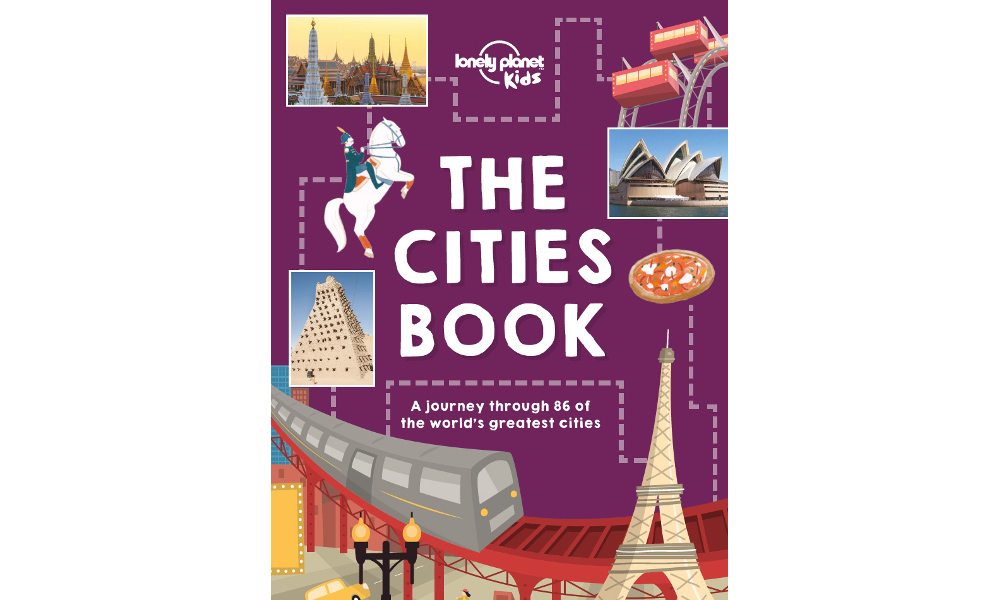
Cities are a way of life for many millions of people in the United States, and for billions around the world. There are some distinct advantages to living somewhere with a high density population: culture, intellectual resources, diversity, the ease of finding other people, and shorter travel distances (though not always shorter travel times). Cities have so much to offer everyone, children included. But where to begin?
First, help your kids learn how cities work. Much of what makes a city functional is hidden: behind walls, overhead, and most of all, underground. How Cities Work from Lonely Planet Kids goes through all of the infrastructure of a city, with plenty of flaps to open and pages to unfold. It’s an interactive tour of everything from parks to sewers, detailing the fun, the interesting, and the smelly. The book includes seemingly endless facts interspersed with colorful illustrations.
The book begins by showing how cities develop, from a small village to a small town to a large town, and, finally, to a city. This book is a budding urban planner’s delight. There aren’t a lot of pages, but each one has very detailed, thorough illustrations and informative captions. Kids as young as five (or even younger, since the pages are fairly sturdy) will study these pages, following the lines of commuters, peeking into apartment living, following along on construction projects, seeing what life is like in tall buildings, visiting parks and gardens, riding the subway, visiting City Hall, learning about all of the emergency services (hospitals, police, and fire), joining in with culture and recreation, comparing space usage between night and day, and opening and closing more flaps and fold-out pages than you thought could be crammed in such a short book. It also challenges kids to consider what cities of the future might look like. The large format book allows for so much to be covered on each page, yet the illustrations aren’t too busy. There is just enough going on to convey a busy city without feeling overwhelming to kids. It’s enough to make me want to buy a few hundred acres and start my own city. Well, maybe I’ll just design one on paper.
The book continues Lonely Planet Kids’ high quality line of products for kids and their attention to detail. They’ve really worked hard to create fun, informative, and educational materials in recent years, and How Cities Work is a prime example. There is so much contained in this book that even parents will learn something if they read through it with their kids (or on their own—who am I kidding?).
How Cities Work is high on my list to give to any kids who are curious about how the things they see every day work and how people function in such close quarters. This book will be taken out to read again and again, and kids will likely learn something new each time. I know I did. (Did you know that many large banks keep their most valuable holdings underground? I didn’t.)

Next up for teaching your kids about cities, travel to other cities around the world, even if you can only do so virtually. The Cities Book is another fantastic title from Lonely Planet Kids, aimed at kids eight and up. Covering 86 cities all over the world, both well-known cities and ones you’ve likely not heard of, this book is just densely packed with perhaps your child’s first world tour.
The book begins by showing a world map with each city in the book marked, along with its page numbers. Next comes a short introduction to how the pages are arranged, and then it jumps right into its first city, Toronto, Canada. There is also a comprehensive index in the back. Each city gets its own two-page spread, which covers an abundance of facts about a city (though some larger cities have two spreads, such as New York City and Paris), and also includes photos and illustrations of some of the most memorable parts of that city. The book covers attractions, history, culture, infrastructure, food, holidays, and what cities are generally known for.

Though readers only get a brief overview trip to each city, the book does a good job giving a taste of the unique aspects of each. Certain cities might pique the interest of your kids, and this book can be a jumping off point for further study (and trip planning!). And, with 86 cities contained in the large-format book, there is something for every taste. Every continent but Antarctica is represented.
Challenge your kids to find facts that they don’t already know for both well-known and lesser-known cities. Even though I thought I knew a lot about Copenhagen, for example, I learned about a few locations and facts (such as Rundetaarn Tower/Observatory) that make me want to visit there even more. And, did you know there is a Currywurst Museum in Berlin? Make note of which cities appeal to your kids. This may help you plan a trip in the future!
The Cities Book is an engrossing resource for learning about what dozens of cities around the world have to offer, and their history and background. The authors don’t skip over difficult aspects of history and life, either. Though there’s nothing graphic, topics such as war and slimy food are included to give a more representative look at the world.
I wish I’d had both of these books when my kids were smaller. Good thing I can hold onto them for the grandkids.
Note: Copies of these books were provided for review purposes.



